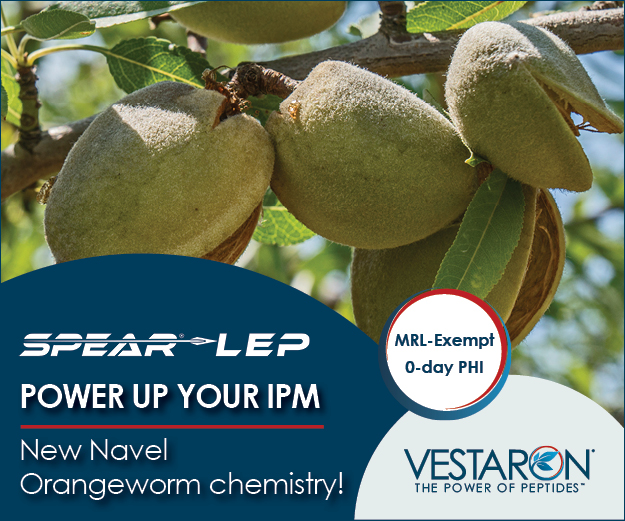
Orchards that had ‘hot spots’ of leaffooted bugs (LFB) last year are likely to have a recurrence of infestation again this year. As vegetation near orchards dries up or when cover crops in the orchard are mowed, LFB may move into tree canopies where they can lay eggs and feed on developing nuts.
Houston Wilson, Assistant Cooperative Extension Specialist at the UC Kearney Ag Center in Parlier, said no large buildup of LFB populations in pistachios has been reported to him this year, but warmer and drier winters like this past one are likely to keep this pest more viable while they are overwintering.
There are three species of LFB in California. All three are similar in appearance— brown/black in color with a narrow white band across the back and the familiar leaf-shaped rear legs. Wilson said the Leptoglossus zonatus species is now dominant in California tree nut orchards, displacing Leptoglossus clypealis, which is now less than 5% of LFB population. Leptoglossus zonatus can be distinguished by the presence of two large white/yellow spots just behind the head. The third LFB species is Leptoglossus occidentalis, but it is rarely found in orchards.
LFB overwinter in sheltered areas in and around orchards. As weather warms in the spring, the adult LFB disperse to feed on new crop nuts as well as lay eggs, which can be on leaves, twigs and nuts. Adults, nymphs and eggs can initially be found in almond orchards in the spring, but in June can turn up in pistachios. The insect has two to three generations per year depending on temperatures and food sources.
Wilson said pistachio nuts are vulnerable to LFB feeding in June. They typically damage many of the nuts in a single cluster. In orchards where feeding damage was found last year, or where adult LFB have been previously observed, growers should monitor carefully for LFB presence by beat sampling the tree canopy or looking for egg masses.
Sampling should ideally take place in the spring, Wilson said, especially where populations are known to be established. Sampling in the morning when LFB are less active, in multiple trees and where hot spots were found in previous years is advised. There is no economic threshold for LFB numbers, so when growers find adults or feeding lesions on developing nuts, use of pesticides should be determined by previous experience with LFB populations and damage in that block. Wilson noted that LFB are not true vectors of diseases, but their feeding can introduce harmful pathogens.
Early season LFB feeding causes nuts to drop. After shell hardening in June, LFB feeding may cause kernel necrosis. Externally, all that is evident is a brown pinpoint mark. With kernel necrosis, the nutmeat is darkened and often develops a sunken or distorted area, and may have an off-flavor.
Pyrethroid applications work on all life stages of LFB. Adults may fly out of the orchard during the spray application, but the material has enough of a residual effect to kill adults, Wilson said.
Other methods of control being researched include biocontrol with parasitoids and trap crops.











